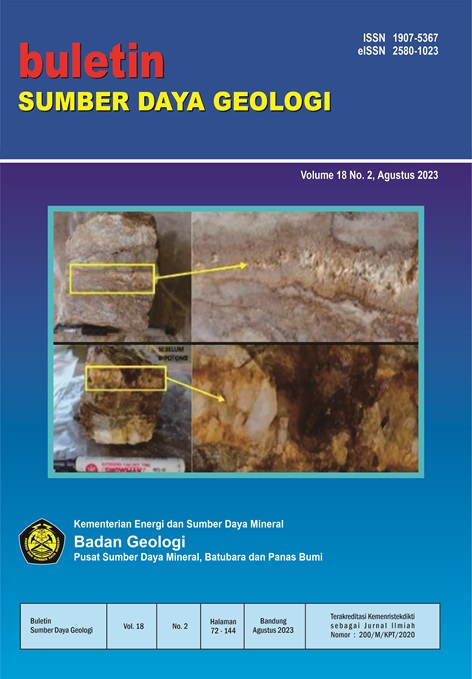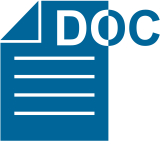MINERALOGI BIJIH DAN KORELASI ANTARA UNSUR Au DENGAN UNSUR Ag, Cu, Pb, DAN Zn PADA SAMPEL PARITAN UJI PIT X PT NUSA HALMAHERA MINERALS, KABUPATEN HALMAHERA UTARA, PROVINSI MALUKU UTARA
ORE MINERALOGY AND CORRELATION BETWEEN THE ELEMENT OF Au WITH ELEMENTS OF Ag, Cu, Pb, AND Zn IN TRENCH’S SAMPLE OF PIT X PT NUSA HALMAHERA MINERALS, NORTH HALMAHERA REGENCY, NORTH MALUKU PROVINCE
Abstract
The identification of deposits and mineralogical characteristics of ores is necessary to assist further exploration development activities. Research in the Pit X test trench area was conducted to determine the type of epithermal deposits based on the deposite form, ore mineral texture, alteration, sulfide minerals, and gangue minerals that are dominantly found from the results of direct megascopic sample descriptions in the Pit X test trench area, mineragraphic analysis, and petrographic analysis. Deposite forms encountered are vein, stockwork, and dissemenited. Ore mineral textures encountered are banded, comb, dogteeth, moss, vuggy and massive. Alterations encountered are silicification and silica-clay. Sulfide minerals found are pyrite and sphalerite. Gangue minerals found are quartz, sericite, and hematite. Based on the results of the deposite form, ore mineral texture, alteration, sulfide minerals, and gangue minerals found, the Pit X test trench research area is included in the low sulfide epithermal deposit type at a depth of about 300-350 m below the surface, deposited above the boiling zone. In this study, additional data processing was carried out regarding the correlation between Au and Ag, Cu, Pb, and Zn using the results of their grade values to determine the relationship between Au and each of the other four elements. The correlation coefficient (R) was obtained between Au-Ag = 0.158429795, Au-Cu = 0.01, Au-Pb = 0.1923538, and Au-Zn = 0.0565685425. Based on these results, it shows that the correlation of Au with Ag, Cu, Pb, and Zn is very low which may be due to the presence of all samples from the same elevation
Downloads
References
Apandi dan Sudana. (1980). Peta Geologi Lembar Ternate, Maluku Utara. Pusat Penelitian dan Pengembangan Geologi, Bandung.
Buchanan. (1981). Hydrothermal Processes And Mineral Systems: Model Of Epithermal Styles. Geological Survey of Western Australia, Australia.
Bessho. (1944). Zona Sesar Maluku Utara, Dalam Hamilton 1979, Institut Teknologi Bandung. Dep Umum Research Nasional, Jakarta.
Briyantara, S.S. dan Yulianto, T. (2015). Aplikasi Metode Magnetik untuk Melokalisasi Target Zona Mineralisasi Emas di Daerah “X”. Youngster Physics Journal, 4(1), 1-6.
Carlile dan Mitchell. (1994). Magmatic Arcs adn Associated Gold and Copper Mineralization in Indonesia. Journal of Geochemical Exploration 50 (1-3): 91- 142.
Clark, L.V. (2012). The geology and genesis of the Kencana epithermal Au-Ag deposit, Gosowong Goldfiels, Halmahera Island, Indonesia. Ph.D Thesis at CODES University of Tasmania, h. 1-14.
Hedenquist, J.W. et al. 2000. Explorationfor Epithermal Gold Deposit. SEG Reviews Vol. 13, 2000, p . 245-277.
Katili, J.A. (1974). Geologi Daerah Halmahera Barat. Institut Teknologi Bandung. Departemen Umum Research Nasional, Jakarta.
Pracejus, B. (2015). The Ore Minerals Under The Microscope. Second Edition. Elsevier, Amsterdam.
Sarwono, Jonathan. 2009. Statistik itu Mudah Panduan Lengkap untuk Belajar Komputasi Statistik Menggunakan SPSS 16. Penerbit Andi, Yogyakarta.
Sugiyono. (2006). Metode Penelitian Kuantitatif, Kualitatif dan R & D. Alfabeta, Bandung.
Supriatna, S. (1980). Modifikasi Peta Geologi Lembar Morotai – Maluku Utara. Pusat Survey Geologi, Bandung.terhadap Au sedangkan Cu, Pb, dan Zn tidak memiliki pengaruh terhadap Au.
Copyright (c) 2023 Buletin Sumber Daya Geologi

This work is licensed under a Creative Commons Attribution-NonCommercial-ShareAlike 4.0 International License.
Authors whose manuscripts are published agree to the following terms:
The publication rights of all journal manuscript materials published on the Buletin Sumber Daya Geologi website are held by the editorial board with the knowledge of the author (moral rights remain with the manuscript’s author).
The formal legal provisions for access to digital articles in this electronic journal are subject to the terms of the Creative Commons Attribution-ShareAlike (CC BY-SA) license. This means that Buletin Sumber Daya Geologi has the right to store, convert media/formats, manage in the form of a database, maintain, and publish the article without requesting permission from the author, as long as the author’s name is cited as the copyright holder.
Manuscripts published in both print and electronic formats are open access for educational, research, investigative, and library purposes. Beyond these purposes, the editorial board is not responsible for any violations of copyright law.















